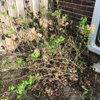A Very Basic Question
jxa44
17 years ago
Related Stories

WORKING WITH PROS10 Questions to Ask Potential Contractors
Ensure the right fit by interviewing general contractors about topics that go beyond the basics
Full Story
CONTAINER GARDENSContainer Garden Basics: How and When to Water Potted Plants
Confused about soil moisture, the best time to water and what watering device to use? This guide can help
Full Story
KITCHEN DESIGN9 Questions to Ask When Planning a Kitchen Pantry
Avoid blunders and get the storage space and layout you need by asking these questions before you begin
Full Story
WORKING WITH PROS12 Questions Your Interior Designer Should Ask You
The best decorators aren’t dictators — and they’re not mind readers either. To understand your tastes, they need this essential info
Full Story
REMODELING GUIDESSurvive Your Home Remodel: 11 Must-Ask Questions
Plan ahead to keep minor hassles from turning into major headaches during an extensive renovation
Full Story
REMODELING GUIDESConsidering a Fixer-Upper? 15 Questions to Ask First
Learn about the hidden costs and treasures of older homes to avoid budget surprises and accidentally tossing valuable features
Full Story
DOORS5 Questions to Ask Before Installing a Barn Door
Find out whether that barn door you love is the right solution for your space
Full Story
SELLING YOUR HOUSE15 Questions to Ask When Interviewing a Real Estate Agent
Here’s what you should find out before selecting an agent to sell your home
Full Story
LIGHTING5 Questions to Ask for the Best Room Lighting
Get your overhead, task and accent lighting right for decorative beauty, less eyestrain and a focus exactly where you want
Full Story
MOST POPULAR8 Questions to Ask Yourself Before Meeting With Your Designer
Thinking in advance about how you use your space will get your first design consultation off to its best start
Full Story








tjsangel
duluthinbloomz4
Related Professionals
Fitchburg Landscape Architects & Landscape Designers · New Mexico Landscape Architects & Landscape Designers · White Oak Landscape Architects & Landscape Designers · Anderson Landscape Contractors · Elgin Landscape Contractors · Americus Landscape Contractors · Biloxi Landscape Contractors · Concord Landscape Contractors · Middleton Landscape Contractors · Middletown Landscape Contractors · Norwalk Landscape Contractors · Paso Robles Landscape Contractors · Secaucus Landscape Contractors · Teaneck Landscape Contractors · Westchester Landscape Contractorsrhizo_1 (North AL) zone 7
leslie197
donn_
jxa44Original Author
bean_counter_z4
natvtxn
jxa44Original Author
anna_beth
nancyd